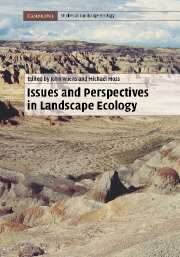Book contents
- Frontmatter
- Contents
- List of contributors
- Preface
- PART I Introductory perspectives
- PART II Theory, experiments, and models in landscape ecology
- PART III Landscape patterns
- PART IV Landscape dynamics on multiple scales
- PART V Applications of landscape ecology
- 18 Landscape ecology as the broker between information supply and management application
- 19 Farmlands for farming and nature
- 20 Landscape ecology and forest management
- 21 Landscape ecology and wildlife management
- 22 Restoration ecology and landscape ecology
- 23 Conservation planning at the landscape scale
- 24 Landscape conservation: a new paradigm for the conservation of biodiversity
- 25 The “why?” and the “so what?” of riverine landscapes
- PART VI Cultural perspectives and landscape planning
- PART VII Retrospect and prospect
- Index
- Plate section
- References
23 - Conservation planning at the landscape scale
from PART V - Applications of landscape ecology
Published online by Cambridge University Press: 20 November 2009
- Frontmatter
- Contents
- List of contributors
- Preface
- PART I Introductory perspectives
- PART II Theory, experiments, and models in landscape ecology
- PART III Landscape patterns
- PART IV Landscape dynamics on multiple scales
- PART V Applications of landscape ecology
- 18 Landscape ecology as the broker between information supply and management application
- 19 Farmlands for farming and nature
- 20 Landscape ecology and forest management
- 21 Landscape ecology and wildlife management
- 22 Restoration ecology and landscape ecology
- 23 Conservation planning at the landscape scale
- 24 Landscape conservation: a new paradigm for the conservation of biodiversity
- 25 The “why?” and the “so what?” of riverine landscapes
- PART VI Cultural perspectives and landscape planning
- PART VII Retrospect and prospect
- Index
- Plate section
- References
Summary
A major challenge for the science of ecology, to make it relevant, is to build a bridge between the local scale of reductionist science and the landscape scale of planning and decision making. This is, of course, the task that landscape ecology has set for itself. Planning for biodiversity conservation is a practice that illustrates the opportunities, as well as the risks and challenges, in bringing ecological science to bear on problems in the real world of human activities.
The objective of conservation planning is to balance production and other forms of exploitation with the conservation of biodiversity in a way that allows for the realization of the evolutionary potential of as many life forms as possible. To help achieve this objective, some areas within regions (countries, biomes, landscapes, etc.) should be primarily managed for the protection of biodiversity. I will call these biodiversity priority areas. Priority areas will not encompass all biodiversity nor will they sustain the biodiversity they encompass over time if they are managed in isolation from the surrounding matrix of other natural, semi-natural, and production lands. However, biodiversity priority areas should form the core of biodiversity conservation plans.
Not many existing protected areas (current biodiversity priority areas) were selected with an explicit biodiversity goal in mind. Some were chosen for their outstanding natural beauty and others because they protected rare species or wilderness values. Most were chosen because there were few competing land uses (Pressey, 1994).
- Type
- Chapter
- Information
- Issues and Perspectives in Landscape Ecology , pp. 230 - 237Publisher: Cambridge University PressPrint publication year: 2005
References
- 1
- Cited by



